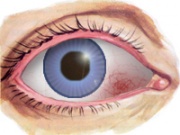Contents |
Episcleritis
Introduction
The medical term for the white part of the eye is sclera; the sclera consists of the white part of the eye we see when we look at the eyes of others or ourselves in a mirror, but it also continues completely around the globe itself. The sclera is composed of fibrils of connective tissue which form a strong sheath to lend structure and support to the eye and the tissues it contains. It could be said that the sclera is the part of the eye that keeps the inside in and the outside out, maintaining the integrity of the eye. The sclera is very tough and forms part of the defense system of the eye. There are several layers of tissue that make up the sclera, the outermost one being the episclera.
Episcleritis is an acute inflammation of the upper part of the sclera, most usually the part that is exposed to the air, in one of the corners of the eye.
Inflammation is part of the immune response of the body; it is not an infection, but usually results in redness, pain or achiness and swelling of the tissues involved.
Symptoms
Episcleritis is usually only found in one eye, although it can affect both. The inflammation may be found in the form of a focal area, or nodule, although sometimes it can affect the entire episclera in a more diffuse form.
The eye will be tender to the touch, and be mildly sensitive to light, and there may be some mild pain on moving the eye.
The redness in the eye will usually be in one sector (see illustration) and will be a deeper and more purplish color than the usual small blood vessels in the conjunctiva overlying the sclera.
Causes
Most patients with episcleritis have no identifiable underlying illness that could trigger the inflammatory response. A small percentage of cases may be associated with other inflammatory diseases such as rheumatoid arthritis, lupus, herpes zoster, gout, syphilis and Crohn’s Disease.
Episcleritis typically affects young adults. Recurrent episodes are common throughout life.
Treatment
Most cases of episcleritis will resolve on their own with treatment or without, usually between seven to ten days after initial onset.
Treatment of the symptoms of the inflammation can be used, such as cold packs, anti-inflammatory medications like ibuprofen and naproxen, or topical eye drops containing steroids. Treatment is used to increase comfort, and will have no effect on how long or severe a particular episode may be.
If symptoms are severe, it is necessary to rule out a more serious inflammation involving the entire sclera called scleritis. Scleritis affects the deeper tissues of the sclera and may be characterized by severe pain and intense redness.
Summing Up
Episcleritis is an annoying and irritating condition, but it is usually not serious and will resolve on its own. Treatment is to reduce the symptoms of the inflammation, using cold packs, over the counter medications to reduce swelling and redness and steroidal eye drops if needed to increase comfort until the episode quiets on its own.
Episcleritis can be mistaken for other ocular problems (conjunctivitis or iritis, for example) both less serious and more so; it is therefore important to see an eyecare practitioner to be sure of the diagnosis and to rule out other, more serious conditions.


